- GreenMatch
- Blog
- Soap
Is Soap Bad For the Environment? Statistics, Trends & Facts

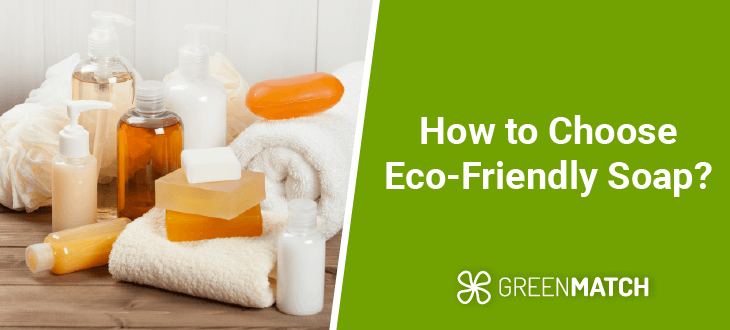
The inglorious pandemic has taught us all a valuable lesson: wash, wash, wash your hands. Always and everywhere, keep them clean.
Undoubtedly, with over 703 million coronavirus pandemic cases (and counting), this simple act of hygiene has proven to be a powerful defence against the spread of infectious diseases.
With soap standing in the centre of this routine, we don't question its impact on nature. Yet, as we navigate the pandemic, we must delve into the environmental consequences of our hygiene practices.
Yet, is soap bad for the environment? Are there eco-friendly soap options available? Can we strike a balance between personal health and environmental responsibility?
This article will soak in (pun intended) the ecological footprint of soap and explore the environmental impact of commonly used ingredients, packaging and disposal methods.
- What do we mean by soap exactly?
- Brief history of soap
- Is soap sustainable?
- Environmental impact of soap
- Environmental impact of soap compared to everyday things
- Is soap toxic?
- What are soap alternatives?
- Are there sustainable soap options?
- Is soap biodegradable?
- Can you recycle soap?
- Soap in the largest economies
- Soap industry trends
- Statistics, facts, and figures on soap
- FAQ
What do we mean by soap exactly?
To truly grasp the concept of "soap," we must consider its defined regulations and environmental impact. According to regulations, soap mainly comprises salts derived from fatty acids.
Soaps are typically made from substances such as plant oils or animal fats. These types of soaps are biodegradable. They are generally less harmful to the environment than detergents.
However, it's important to note that soap production still carries risks, including using valuable natural resources and the possibility of pollution.
Brief history of soap
Before discussing whether soap harms the environment today, let's see how it all began.
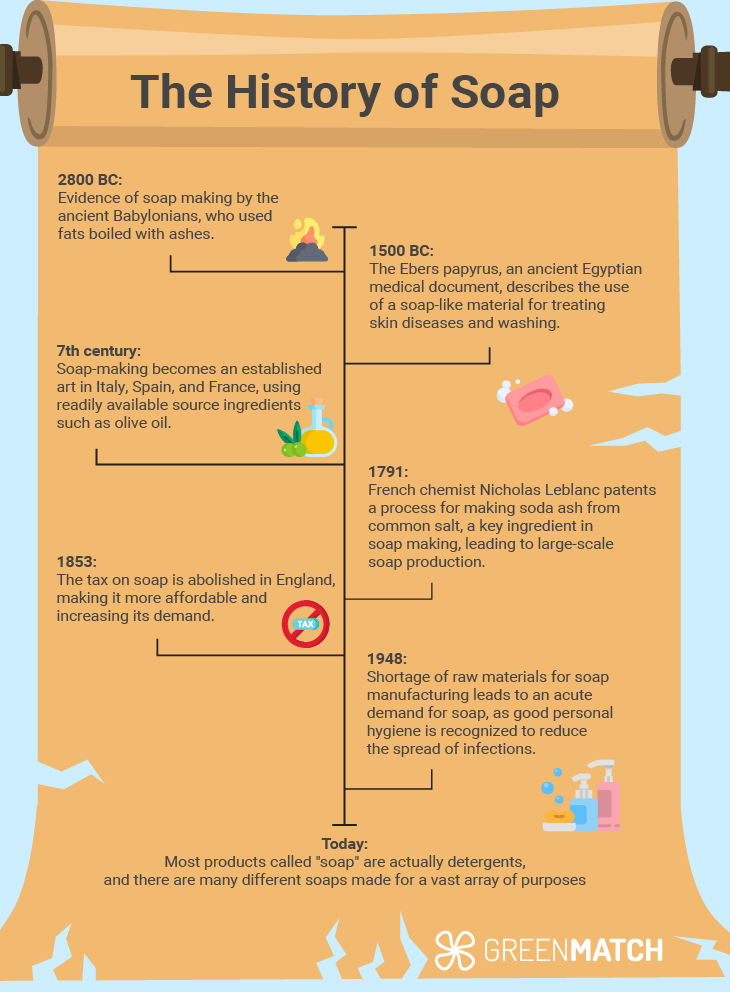
In ancient times, soap-like substances were discovered in Ancient Babylonia (2800 BC) and Ancient Egypt (1550 BC), showcasing early recipes using alchemical mixtures of fats and ashes.
The Roman Empire saw soap evolve into a medicinal commodity. European soap use declined in the Middle Ages, while the Arab world embraced innovations. By the 7th century, soap-making in Europe had become regulated.
The 19th century brought a transformative era with William Sheppard's 1865 liquid soap patent, revolutionising personal hygiene. However, the mid-20th century saw the rise of synthetic detergents, challenging traditional soap and raising environmental concerns.
Is soap sustainable?
The sustainability of soap depends on various factors, including its ingredients, production processes, and packaging.
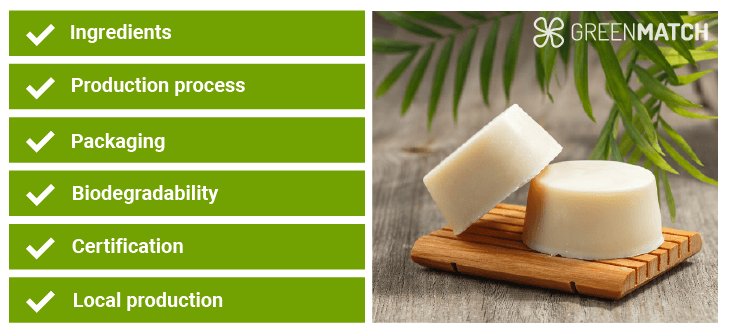
Here are some considerations:
- Ingredients: Traditional soaps are often made from natural ingredients like oils or fats and alkali such as sodium hydroxide (lye). These ingredients can be sustainable if sourced responsibly. Some soaps also contain synthetic additives or palm oil, the production of which may contribute to deforestation and environmental degradation.
- Production processes: Some companies employ eco-friendly practices, such as using energy-efficient processes, reducing water consumption, and minimising waste. Sustainable certifications, like USDA Organic or Rainforest Alliance, can indicate environmentally friendly practices.
- Packaging: Minimal and green packaging, such as recyclable or compostable materials, is a positive factor. Some companies are also adopting refillable or bulk options to reduce packaging waste.
- Biodegradability: Traditional soap is generally biodegradable, meaning it breaks down naturally over time without causing harm to the environment. This is an essential factor in assessing its environmental impact.
- Certifications: Look for certifications like cruelty-free, vegan, or eco-friendly, as they can indicate a commitment to sustainable and ethical practices in producing soap.
- Local production: Locally produced soaps may have a lower carbon footprint than products transported long distances. Supporting local businesses can contribute to a more sustainable supply chain.
Reading product labels, checking for certifications, and researching the company's practices can help you make informed choices for more sustainable soap options.
Environmental impact of soap
Any eco-conscious individual should understand that the environmental impact of any product stretches beyond its actual use phase. When considering the environmental impact of soap, we need to factor in several factors:

Let's see how they shape the overall sustainability profile of soap.
Ingredients and production
The simplest soapmaking recipe calls for water, lye and oils. A common recommendation is to use a water-to-lye ratio of 2:1.
However, the modern cosmetics industry has reached the point where soap not only cleans but serves multiple purposes. Thus, soap needs to contain additional chemical components to serve those purposes.
Here are some of the most common chemical ingredients in soap:
- Surfactants: Surfactants are surface-active agents that help break down and remove dirt, oils, and grease from surfaces. They lower the surface tension of water, allowing it to spread and penetrate substances more effectively. Common surfactants in soaps include sodium lauryl sulphate and sodium laureth sulphate.
- Emollients and moisturisers: Some chemicals provide soap with moisturising and emollient properties. These ingredients help prevent skin drying and contribute to a more pleasant texture. Examples include glycerin, shea butter, and various oils.
- Preservatives: To extend the shelf life of the soap and prevent the growth of bacteria and moulds, parabens and phenoxyethanol may be added. This helps maintain the integrity and safety of the product over time.
- Fragrances: Chemical compounds give soaps pleasant scents. Fragrances can enhance the user experience and make the soap more appealing.
- Colourants: Some soaps may contain colourants like synthetic dyers to give them a specific appearance. These can be synthetic or natural compounds (like turmeric or spirulina) used for aesthetic purposes.
- Stabilisers: Tetrasodium EDTA and butylated hydroxytoluene stabilise the formulation of the soap, ensuring that it maintains a consistent texture and appearance throughout its shelf life.
Additionally, recent studies found that triclosan and phosphates contribute to antibiotic resistance in bacteria, aquatic ecosystem disruption, and nutrient pollution.
Water consumption and waste
World Health Organisation recognises regular 20-30 second handwashing with soap as a vital tool to fight the coronavirus spread.
At the same time, a single handwashing with a tap closed requires around 2L of water and 4L when the tap is open. This elevates the wastewater generation by 15–18%. This affects greatly the freshwater when released there without any treatment.
Taking into account that an average hand washer uses between 0.4 and 9 ml of soap during each procedure, frequent handwashing boosts the pressure on the ecosystem.
Excessive detergents in freshwater can result in a large amount of foam forming on the water's surface. This foam reduces the ability of oxygen to penetrate the water, making it challenging for aquatic organisms to effectively absorb dissolved oxygen.
These substances in the aquatic ecosystem change various water characteristics such as pH, turbidity, salinity, and temperature. The decline in water quality negatively affects fish's biochemical and physiological functions, impacting the value of dissolved oxygen crucial for their well-being. This can lead to significant harm to the gills of fish.
To say more, detergents in water pose a danger to aquatic plants, especially corals and seaweed. They cause eutrophication – excessive plant growth due to water oversaturation with nitrogen and phosphorus. Generally, this leads to a less healthy environment for fish and other organisms.
Today, soap manufacturing involves not only the blending of ingredients but also considerable water usage. Thus, considering the above-mentioned water-to-lye ratio, for every 1 ton of bar soap, around 2000 kg of water is needed.
Ingredient sourcing

Soap production often involves ingredients that contribute to deforestation and habitat destruction. For example, palm oil, a common ingredient in soap, is linked to significant environmental degradation due to clearing tropical forests for palm plantations.
This deforestation contributes significantly to greenhouse gas emissions, further exacerbating climate change.
Packaging and waste
As the global soap market is projected to grow to £43.80 billion by 2030 (from £26.68 billion in 2021), the industry's environmental impact will undoubtedly grow.
But it would be wrong to assume that the soap industry hadn't influenced the environment before that. Apart from the potentially harmful ingredients, packaging is another component that comes together with soap.
On the one hand, soap packaging is important for the product's safe distribution, storage, sale, shipping, and use. Typically, soap packaging comprises waxed paper, aluminium, polyethylene glycol-coated paper, and cellophane.
On the other hand, containers and packaging contribute to the generation of wastewater, hydrocarbon pollution, and air emissions.
Eventually, most of the packaging ends up in landfills, open dumps, or burning, in most cases, with zero chance of decomposition.
To tackle this problem, soap manufacturers should limit the use of packing materials, reduce their weight, and use recycled materials. This approach can be called the 3 'R's strategy: Reduce, Reuse, Recycle.
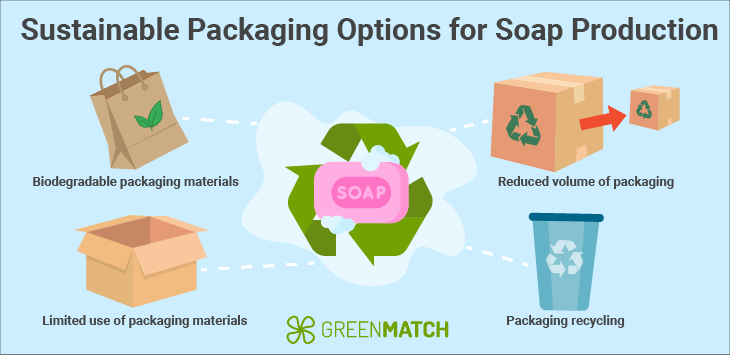
Multiple studies suggest that paper-free packaging, high-density polyethene pourable bottles, refill packaging and returnable packaging can resolve the issue with a contaminating factor of soap packaging.
Environmental impact of soap compared to everyday things
Soap is a relatively environmentally friendly product based on the type of soap, packaging, usage patterns, and production process.
Here's a comparison of soap to some other everyday things:
- Paper towels – require trees to be cut and usually end up in landfills.
- Wipes – wipes are usually made from non-renewable resources and aren't biodegradable.
- Single-use plastics (straws, utensils) – lots of single-use plastics contribute significantly to ocean pollution. Some liquid soaps also come in plastic containers, yet bar soap, if packaged sustainably, can be a better choice.
- Laundry detergent – some detergents, like soap, contain phosphates, thus contributing to water pollution.
- Shampoo – Some shampoos contain microplastics, which harm aquatic life.
So, if you want soap to be a part of your sustainable lifestyle, choose soaps made with vegetable oils and lye, consider using reusable cloths instead of paper towels and wipes and avoid soaps with non-recyclable packaging.
Is soap toxic?
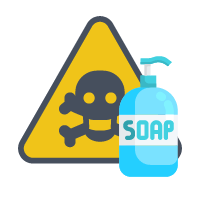
Most soaps aren't toxic, but their toxicity depends on the context.
Yes, soap is definitely toxic when being misused. When ingested, it can cause poisoning, nausea, vomiting, and dehydration. Yet, certain ingredients can also be harmful if we're talking about what's inside the soap.
These are usually:
- Harsh chemicals like sulfates or parabens which irritate and dry out the skin.
- Fragrances and dyes can potentially cause allergic reactions in some people.
- Microbeads – tiny plastic beads added to soap for exfoliation – are toxic to the environment and contribute to microplastic pollution.
- Antibacterial agents that cause antibiotic resistance have yet to be proven more effective than regular soaps.
These components make soap potentially bad for the environment, so read through the ingredient list before purchasing.
What are soap alternatives?
We can certainly get into Ayurvedic and other soap alternatives like vinegar, oils, baking soda, oatmeal, clays, hand sanitisers, micellar water, and such. But let's still emphasise that your health comes first.
- For example, alcohol-based hand sanitisers are effective against coronavirus and other germs, especially when soap and water are unavailable. However, they need more cleaning power than soap and shouldn't be used as a complete replacement.
- Traditional soap has surfactants that lift and remove many microbes from the skin's surface. While some alternatives might have cleansing properties, they aren't as effective in eliminating bacteria and viruses.
- Similarly, vinegar or baking soda can have cleaning properties but, at the same time, disrupt the natural pH of the skin. This can cause irritation and potential long-term skin damage.
So, skim through your soap's ingredient list instead of imbalanced soap alternatives and see whether greener solutions are inside that bar.
Are there sustainable soap options?
Most environmentalists agree that going for biodegradable and natural components in soap reduces its environmental impact.
Here are some biodegradable substitutes:
| Toxic soap ingredient | Biodegradable alternative | Advantage |
|---|---|---|
| Sodium dodecyl sulphate and SLS | Cycteline–octanoyl | Good foaming features, easily breakable into octanoic acid and cysteine in the environment |
| Synthetic fatty acids | Olive oil, orange peels, almond shells, aloe vera, basil, guava leaf, avocado | Green utilisation of waste, good biochemical properties, sunscreen properties* |
| Butylated hydroxytoluene (BHT) and butylated hydroxyanisole (BHA) | Wild berries, ubi gadong | Neutral pH, antioxidant, longer shelf life |
| Triclosan, trichlorocarbanilide, and chloroxylenol | Shea butter oil, palm kernel oil, neem oil | Antimicrobial agent against pathogenic microorganisms |
| Artificial fragrance | Coconut oil, palm oil, primrose oil, jojoba oil | Eco-friendly, safe for the human body |
| Synthetic antimicrobial agents | Green or red betel plant | Antimicrobial action with Staphylococcus aureus |
Various studies between 2018 and 2020 have found that sustainable soap options have an improved shelf life and naturally decompose with time.
Is soap biodegradable?
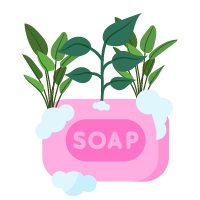
Yes, traditional soap is usually biodegradable. It is considered biodegradable if at least 90% of its composition breaks into water, carbon dioxide, and organic material.
With biodegradable soap, this usually happens within 6 months after use.
In contrast, many non-biodegradable soaps contain persistent chemicals like triclosan and triclocarban, which are resistant to natural breakdown and can't be treated during water treatment.
Moreover, phosphates, another ingredient of regular soaps, also resist breakdown and, therefore, can't be removed from wastewater. However, multiple governments have introduced restrictions and regulations on using phosphates in household cleaning products.
Always check product labels for information on specific ingredients, e.g. phosphate-free, to ensure your environmental impact is as low as possible.
Can you recycle soap?
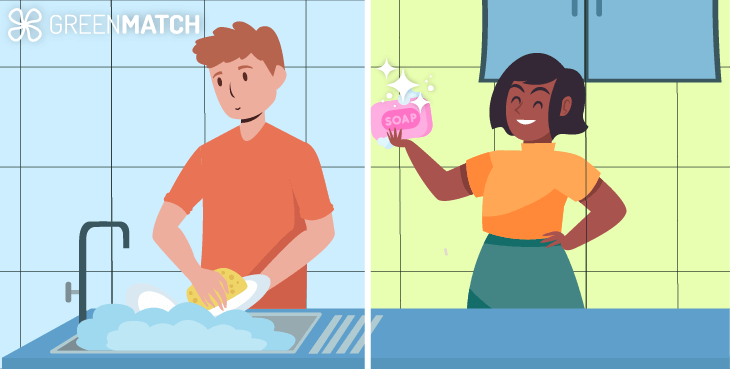
Yes and no.
As a rule, you can't recycle liquid and bar soap through curbside programs due to their composition and contaminating nature. Moreover, it often contains water or other ingredients that aren't suitable for recycling.
Soap packaging is the only part that is generally recyclable so far. However, there are ways to recycle soap: repurposing and upcycling.
- Creating new bars: This DIY project involves collecting leftover soap slivers or small soap scraps and melting them down to create new bars. You can add essential oils or herbs to customise the scent and properties of the soap.
- Repurpose soap: Instead of discarding small soap slivers, you can use them for hand-washing delicate clothes. Grate or finely chop soap into a powder, mix it with water and use it as a natural alternative to commercial laundry detergents.
Soap in the largest economies
Here's an in-depth overview of the global soap market and its growth, with insights into the soap markets in specific countries.
- Global soap market: Asia and the Asia Pacific region hold a big part of the market share, which is attributed to the presence of highly populous countries. Market segmentation includes hypermarkets/supermarkets, pharmacies, and online channels, with hypermarkets/supermarkets anticipated to capture a substantial market share. Bath and body soaps have 76.69% of the global market share, followed by kitchen and laundry soaps.
- US soap market: in 2020, 276.2 million Americans reportedly used soap, and by 2024, this number is expected to grow to 282.58 million. Liquid soaps are more popular than bar soaps, accounting for over 55% of the market share.
- UK soap market: In 2020, the market peaked, outperforming the previous year by 9.02%. In 2020, the liquid soap segment claimed a substantial market share of 70.22%, with the bar soap segment holding 29.78% of the overall market.
- Chinese soap market: In 2021, China's production reached around 1.36 million metric tons, the highest point since 2014. The soap market size in China surpassed 9.2 billion yuan (£10,1 billion) in 2017.
- Latin America's soap market: Brazil is the leading and the most fast-growing market for hand soap in Latin America, with a share of 32.0% of the entire continent.
Soap industry trends
The soap industry is a dynamic and evolving landscape, constantly adapting to consumer preferences and environmental concerns.
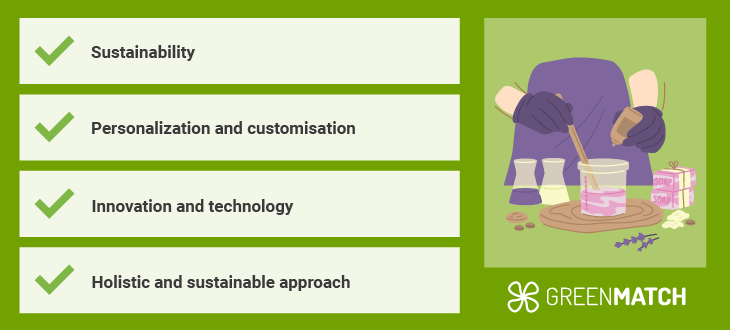
Here are some key trends shaping the future of suds:
Sustainability:
- Natural and organic: Consumers increasingly seek natural and organic soaps made with plant-based ingredients and eco-friendly practices. Concerns about the environmental impact of synthetic chemicals and the desire for healthier options drive this trend.
- Biodegradable and compostable: The demand for soaps that readily decompose and minimise waste is growing, leading to the development of biodegradable and compostable formulas.
- Refill and zero waste: Reducing packaging waste is a major focus, with refillable containers and package-free options gaining traction.
Personalisation and customisation:
- Ingredient tailoring: More often soaps include specific needs in their formulations, addressing concerns like sensitive skin, allergies, or specific skin conditions.
- Fragrance and experience: Consumers are looking for unique and personalised scents and experiences, leading to a rise in niche brands and customised blends.
- Subscription boxes: Curated soap boxes deliver personalised selections based on individual preferences, offering convenience and a sense of discovery.
Innovation and technology:
- Micellar technology: This technology uses micelles, tiny oil-like molecules, to cleanse the skin effectively while being gentle on it.
- Prebiotics and probiotics: Soaps incorporate prebiotics and probiotics to promote a healthy skin microbiome and improve overall skin health.
- Smart soap dispensers: Connected dispensers offer convenience and control, dispensing the right amount of soap and tracking usage patterns.
Holistic and sustainable approach:
- Multi-functional products: Soaps are evolving to serve multiple purposes, such as cleansing, moisturising, and even providing aromatherapy benefits.
- Ethical sourcing and fair trade: Consumers are increasingly conscious of ethical sourcing and fair trade practices, demanding transparency and responsible production.
- Indie and craft soapmakers: The rise of small-batch, artisanal soapmakers offers unique and often more sustainable options.
Ultimately, embracing eco-friendly soap practices, seeking certifications, refilling and reusing containers, and making mindful choices in water usage all contribute to finding the delicate equilibrium between cleanliness and environmental responsibility.
Statistics, facts, and figures on soap
- The market value, which was £33.33 billion, in 2022 is expected to reach around £51.74 billion by 2030. This growth represents a compound growth rate (CAGR) of 5.70%.
- The production of soap ingredients, like palm oil has been associated with deforestation.
- 10 billion pounds of soap are produced globally every year with the United States accounting for one-third of this total.
- Soap and detergent products often contain biodegradable chemicals and antimicrobial components such as triclosan (TCS) and sodium lauryl sulfate (SLS). These substances can disrupt wastewater treatment processes. Have impacts on aquatic ecosystems.
- Around 2.3 billion people still lack hygiene services, including access to soap and water at home.
- The COVID-19 pandemic has significantly raised awareness about the importance of handwashing leading to a surge, in the use of soap.
Hopefully, these insights can guide you towards a harmonious future where personal hygiene and ecological well-being coexist. Happy handwashing!
FAQ
The environmental impact of soap involves its entire life cycle, including production ingredients, packaging, use, disposal, and recycling. Solid and liquid soaps contribute differently to environmental degradation, requiring more energy for production and packaging, leading to a higher carbon footprint.
Bar soap is generally considered more environmentally friendly than liquid soap. A study found that liquid soap’s carbon footprint is about 25% larger than bar soaps on a per-wash basis, requiring five times more energy to produce and nearly 20 times more energy to package.
Deforestation is a significant concern in soap production, especially regarding palm oil, a common ingredient in both traditional soaps and synthetic detergents. Palm oil plantations are an important driver of deforestation, particularly in tropical regions, leading to the loss of biodiversity and the displacement of indigenous peoples.
You can make more environmentally friendly soap choices by choosing bar soaps over liquid soaps, choosing products with minimal and recyclable packaging, and selecting soaps made from sustainable ingredients that don’t contribute to deforestation.
We strive to connect our customers with the right product and supplier. Would you like to be part of GreenMatch?

- What do we mean by soap exactly?
- Brief history of soap
- Is soap sustainable?
- Environmental impact of soap
- Environmental impact of soap compared to everyday things
- Is soap toxic?
- What are soap alternatives?
- Are there sustainable soap options?
- Is soap biodegradable?
- Can you recycle soap?
- Soap in the largest economies
- Soap industry trends
- Statistics, facts, and figures on soap
- FAQ
